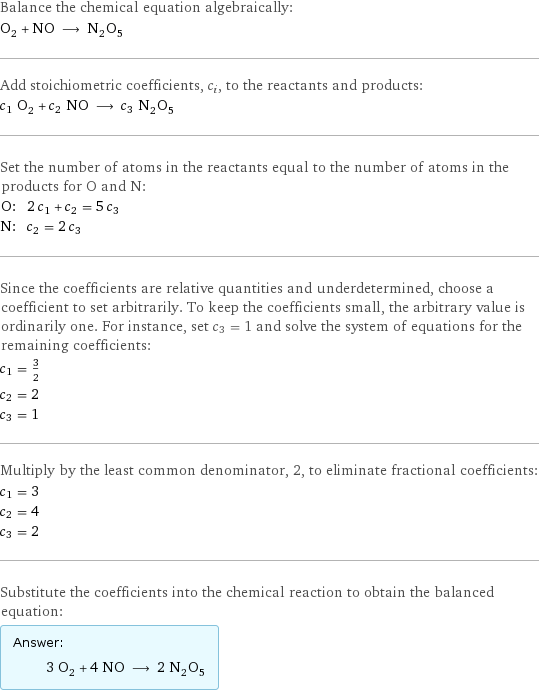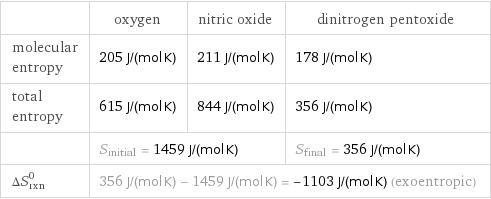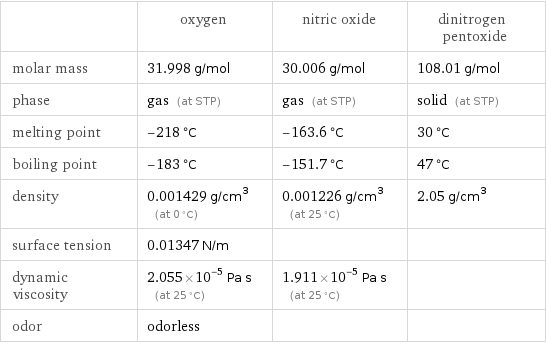Input interpretation

O_2 oxygen + NO nitric oxide ⟶ N_2O_5 dinitrogen pentoxide
Balanced equation

Balance the chemical equation algebraically: O_2 + NO ⟶ N_2O_5 Add stoichiometric coefficients, c_i, to the reactants and products: c_1 O_2 + c_2 NO ⟶ c_3 N_2O_5 Set the number of atoms in the reactants equal to the number of atoms in the products for O and N: O: | 2 c_1 + c_2 = 5 c_3 N: | c_2 = 2 c_3 Since the coefficients are relative quantities and underdetermined, choose a coefficient to set arbitrarily. To keep the coefficients small, the arbitrary value is ordinarily one. For instance, set c_3 = 1 and solve the system of equations for the remaining coefficients: c_1 = 3/2 c_2 = 2 c_3 = 1 Multiply by the least common denominator, 2, to eliminate fractional coefficients: c_1 = 3 c_2 = 4 c_3 = 2 Substitute the coefficients into the chemical reaction to obtain the balanced equation: Answer: | | 3 O_2 + 4 NO ⟶ 2 N_2O_5
Structures

+ ⟶
Names

oxygen + nitric oxide ⟶ dinitrogen pentoxide
Reaction thermodynamics
Enthalpy

| oxygen | nitric oxide | dinitrogen pentoxide molecular enthalpy | 0 kJ/mol | 91.3 kJ/mol | -43.1 kJ/mol total enthalpy | 0 kJ/mol | 365.2 kJ/mol | -86.2 kJ/mol | H_initial = 365.2 kJ/mol | | H_final = -86.2 kJ/mol ΔH_rxn^0 | -86.2 kJ/mol - 365.2 kJ/mol = -451.4 kJ/mol (exothermic) | |
Gibbs free energy

| oxygen | nitric oxide | dinitrogen pentoxide molecular free energy | 231.7 kJ/mol | 87.6 kJ/mol | 113.9 kJ/mol total free energy | 695.1 kJ/mol | 350.4 kJ/mol | 227.8 kJ/mol | G_initial = 1046 kJ/mol | | G_final = 227.8 kJ/mol ΔG_rxn^0 | 227.8 kJ/mol - 1046 kJ/mol = -817.7 kJ/mol (exergonic) | |
Entropy

| oxygen | nitric oxide | dinitrogen pentoxide molecular entropy | 205 J/(mol K) | 211 J/(mol K) | 178 J/(mol K) total entropy | 615 J/(mol K) | 844 J/(mol K) | 356 J/(mol K) | S_initial = 1459 J/(mol K) | | S_final = 356 J/(mol K) ΔS_rxn^0 | 356 J/(mol K) - 1459 J/(mol K) = -1103 J/(mol K) (exoentropic) | |
Equilibrium constant
![Construct the equilibrium constant, K, expression for: O_2 + NO ⟶ N_2O_5 Plan: • Balance the chemical equation. • Determine the stoichiometric numbers. • Assemble the activity expression for each chemical species. • Use the activity expressions to build the equilibrium constant expression. Write the balanced chemical equation: 3 O_2 + 4 NO ⟶ 2 N_2O_5 Assign stoichiometric numbers, ν_i, using the stoichiometric coefficients, c_i, from the balanced chemical equation in the following manner: ν_i = -c_i for reactants and ν_i = c_i for products: chemical species | c_i | ν_i O_2 | 3 | -3 NO | 4 | -4 N_2O_5 | 2 | 2 Assemble the activity expressions accounting for the state of matter and ν_i: chemical species | c_i | ν_i | activity expression O_2 | 3 | -3 | ([O2])^(-3) NO | 4 | -4 | ([NO])^(-4) N_2O_5 | 2 | 2 | ([N2O5])^2 The equilibrium constant symbol in the concentration basis is: K_c Mulitply the activity expressions to arrive at the K_c expression: Answer: | | K_c = ([O2])^(-3) ([NO])^(-4) ([N2O5])^2 = ([N2O5])^2/(([O2])^3 ([NO])^4)](../image_source/42cec2fb2de56a2b6e2efa54a4648ab2.png)
Construct the equilibrium constant, K, expression for: O_2 + NO ⟶ N_2O_5 Plan: • Balance the chemical equation. • Determine the stoichiometric numbers. • Assemble the activity expression for each chemical species. • Use the activity expressions to build the equilibrium constant expression. Write the balanced chemical equation: 3 O_2 + 4 NO ⟶ 2 N_2O_5 Assign stoichiometric numbers, ν_i, using the stoichiometric coefficients, c_i, from the balanced chemical equation in the following manner: ν_i = -c_i for reactants and ν_i = c_i for products: chemical species | c_i | ν_i O_2 | 3 | -3 NO | 4 | -4 N_2O_5 | 2 | 2 Assemble the activity expressions accounting for the state of matter and ν_i: chemical species | c_i | ν_i | activity expression O_2 | 3 | -3 | ([O2])^(-3) NO | 4 | -4 | ([NO])^(-4) N_2O_5 | 2 | 2 | ([N2O5])^2 The equilibrium constant symbol in the concentration basis is: K_c Mulitply the activity expressions to arrive at the K_c expression: Answer: | | K_c = ([O2])^(-3) ([NO])^(-4) ([N2O5])^2 = ([N2O5])^2/(([O2])^3 ([NO])^4)
Rate of reaction
![Construct the rate of reaction expression for: O_2 + NO ⟶ N_2O_5 Plan: • Balance the chemical equation. • Determine the stoichiometric numbers. • Assemble the rate term for each chemical species. • Write the rate of reaction expression. Write the balanced chemical equation: 3 O_2 + 4 NO ⟶ 2 N_2O_5 Assign stoichiometric numbers, ν_i, using the stoichiometric coefficients, c_i, from the balanced chemical equation in the following manner: ν_i = -c_i for reactants and ν_i = c_i for products: chemical species | c_i | ν_i O_2 | 3 | -3 NO | 4 | -4 N_2O_5 | 2 | 2 The rate term for each chemical species, B_i, is 1/ν_i(Δ[B_i])/(Δt) where [B_i] is the amount concentration and t is time: chemical species | c_i | ν_i | rate term O_2 | 3 | -3 | -1/3 (Δ[O2])/(Δt) NO | 4 | -4 | -1/4 (Δ[NO])/(Δt) N_2O_5 | 2 | 2 | 1/2 (Δ[N2O5])/(Δt) (for infinitesimal rate of change, replace Δ with d) Set the rate terms equal to each other to arrive at the rate expression: Answer: | | rate = -1/3 (Δ[O2])/(Δt) = -1/4 (Δ[NO])/(Δt) = 1/2 (Δ[N2O5])/(Δt) (assuming constant volume and no accumulation of intermediates or side products)](../image_source/7a5ed8e6036227eb9d98333e47411689.png)
Construct the rate of reaction expression for: O_2 + NO ⟶ N_2O_5 Plan: • Balance the chemical equation. • Determine the stoichiometric numbers. • Assemble the rate term for each chemical species. • Write the rate of reaction expression. Write the balanced chemical equation: 3 O_2 + 4 NO ⟶ 2 N_2O_5 Assign stoichiometric numbers, ν_i, using the stoichiometric coefficients, c_i, from the balanced chemical equation in the following manner: ν_i = -c_i for reactants and ν_i = c_i for products: chemical species | c_i | ν_i O_2 | 3 | -3 NO | 4 | -4 N_2O_5 | 2 | 2 The rate term for each chemical species, B_i, is 1/ν_i(Δ[B_i])/(Δt) where [B_i] is the amount concentration and t is time: chemical species | c_i | ν_i | rate term O_2 | 3 | -3 | -1/3 (Δ[O2])/(Δt) NO | 4 | -4 | -1/4 (Δ[NO])/(Δt) N_2O_5 | 2 | 2 | 1/2 (Δ[N2O5])/(Δt) (for infinitesimal rate of change, replace Δ with d) Set the rate terms equal to each other to arrive at the rate expression: Answer: | | rate = -1/3 (Δ[O2])/(Δt) = -1/4 (Δ[NO])/(Δt) = 1/2 (Δ[N2O5])/(Δt) (assuming constant volume and no accumulation of intermediates or side products)
Chemical names and formulas

| oxygen | nitric oxide | dinitrogen pentoxide formula | O_2 | NO | N_2O_5 name | oxygen | nitric oxide | dinitrogen pentoxide IUPAC name | molecular oxygen | nitric oxide | nitro nitrate
Substance properties

| oxygen | nitric oxide | dinitrogen pentoxide molar mass | 31.998 g/mol | 30.006 g/mol | 108.01 g/mol phase | gas (at STP) | gas (at STP) | solid (at STP) melting point | -218 °C | -163.6 °C | 30 °C boiling point | -183 °C | -151.7 °C | 47 °C density | 0.001429 g/cm^3 (at 0 °C) | 0.001226 g/cm^3 (at 25 °C) | 2.05 g/cm^3 surface tension | 0.01347 N/m | | dynamic viscosity | 2.055×10^-5 Pa s (at 25 °C) | 1.911×10^-5 Pa s (at 25 °C) | odor | odorless | |
Units
